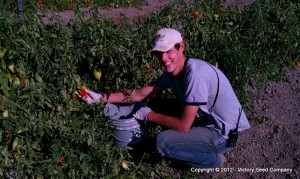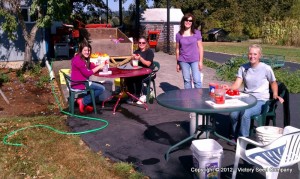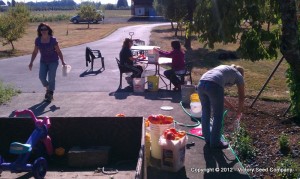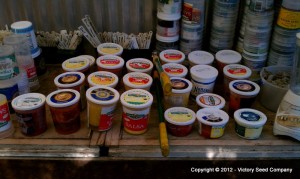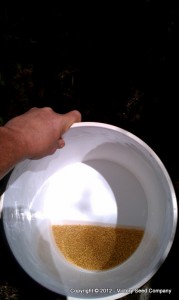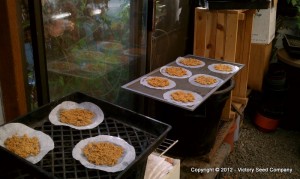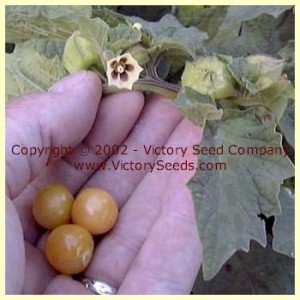This summer was a close repeat to the one that we had last year – cool, wet weather into the first part of July and then mild temperatures all summer. Unlike the rest of the country, we had very few hot days. Now we are trying to harvest everything all at once before either freezing temps or devastating rains zap us..
The result of these weather patterns is that the “early season” tomato varieties have been ripening in late August while the “mid and late season” varieties are ripening late in September and into October. Rain is not threatening – we actually have not had a drop since July and none is forecast in the near future – but the nights have been dipping into the low 30s for the past three days. The cold temps have been a season-ender for the vining crops, the corn and legumes are drying down nicely, and solanace family are all showing some degree of damage.
This means that we are running a big crew (for us anyway) trying to bring in all of the tomato seed that we can before a “real” freeze or rain hits and turns everything to mush. I thought that I would share a short pictorial of the tomato seed harvest process with you all.
Harvesting tomato seeds obviously begins with picking the fruit. Only fully vine ripened tomatoes are processed for seed. Although we spend a lot of time with the plants throughout the growing season, we use this opportunity to document the flavor, textures, interesting characteristics, weights, sizes, and take photographs. Once that is done, the buckets of tomatoes are given to the crew for processing.
As you can see in the photo, this October here on the farm has been really nice. It has started light frosting overnight, but has been in the mid to high 70s during the day so we are able to do this messy work comfortably outside for a change. This is a photo of the crew squeezing tomatoes that John picked. During this seed removal stage, the crew only works with one variety and then cleans everything up before moving on to a new variety.
Since the primary purpose of our work is preserving old varieties, accuracy is a key part of our mission. Starting with proven seed, our grow outs are carefully monitored throughout the season and compared to the historical record for the particular variety as well as to our past grow out data. Neat, tidy and following procedure is critical during the seed saving stage.
Those of you that have read my thoughts on the subject of repurposing or have watched the videos know that I am a big fan of keeping useful “trash” out of the the garbage stream and even out of the recycling bin. If you can find a new use for an old item, it is just plain smart.
So in that vein, we have our friends and family save their plastic salsa, sour cream, and humus containers for us and use them for fermenting the tomato seed harvest. (FYI – The containers last four or five years but the lids only only about three) I have found that the perfect place on our farm for fermentation is in our potting shed. If the temperatures are just right, the seeds are ready to be washed in three days.
Aren’t they pretty? ![]() This happens to be a nice batch of ‘Millet’s Dakota‘ seed.
This happens to be a nice batch of ‘Millet’s Dakota‘ seed.
Folks have different methods for drying. My way of doing it is to place the wet seeds, about a cup of them, onto a paper coffee filter, gently wring out as much water as possible without tearing the filter, and then spread the ball of seeds out and allow them to dry. As a rule, I let them start the drying process in the potting shed that first day and move them into the barn that evening where I have fans going. And to prevent any possible disasters from happening, I keep different varieties far away from each other. All of the seeds in the above picture is the same variety. After about week, the clumps of seeds can be crumbled and screened to remove and small seeds and dust. And that is the process in a nutshell.
If you are interested in more detail about how to save your own tomato seeds, click here. And as always, thank you for supporting our seed variety preservation work. We could not do this without you!
